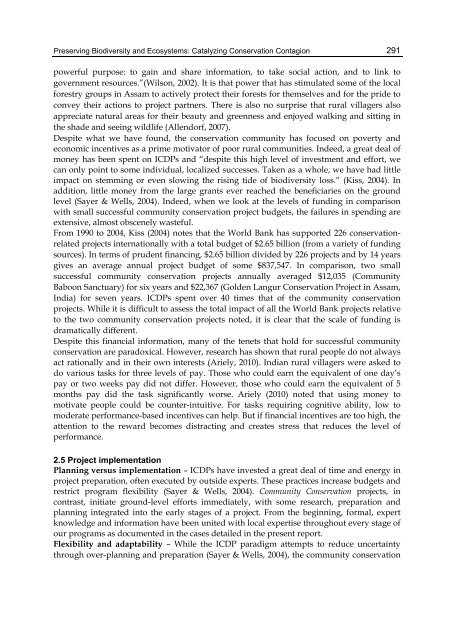DEFORESTATION AROUND THE WORLD - India Environment Portal
DEFORESTATION AROUND THE WORLD - India Environment Portal
DEFORESTATION AROUND THE WORLD - India Environment Portal
Create successful ePaper yourself
Turn your PDF publications into a flip-book with our unique Google optimized e-Paper software.
Preserving Biodiversity and Ecosystems: Catalyzing Conservation Contagion<br />
powerful purpose: to gain and share information, to take social action, and to link to<br />
government resources.”(Wilson, 2002). It is that power that has stimulated some of the local<br />
forestry groups in Assam to actively protect their forests for themselves and for the pride to<br />
convey their actions to project partners. There is also no surprise that rural villagers also<br />
appreciate natural areas for their beauty and greenness and enjoyed walking and sitting in<br />
the shade and seeing wildlife (Allendorf, 2007).<br />
Despite what we have found, the conservation community has focused on poverty and<br />
economic incentives as a prime motivator of poor rural communities. Indeed, a great deal of<br />
money has been spent on ICDPs and “despite this high level of investment and effort, we<br />
can only point to some individual, localized successes. Taken as a whole, we have had little<br />
impact on stemming or even slowing the rising tide of biodiversity loss.” (Kiss, 2004). In<br />
addition, little money from the large grants ever reached the beneficiaries on the ground<br />
level (Sayer & Wells, 2004). Indeed, when we look at the levels of funding in comparison<br />
with small successful community conservation project budgets, the failures in spending are<br />
extensive, almost obscenely wasteful.<br />
From 1990 to 2004, Kiss (2004) notes that the World Bank has supported 226 conservationrelated<br />
projects internationally with a total budget of $2.65 billion (from a variety of funding<br />
sources). In terms of prudent financing, $2.65 billion divided by 226 projects and by 14 years<br />
gives an average annual project budget of some $837,547. In comparison, two small<br />
successful community conservation projects annually averaged $12,035 (Community<br />
Baboon Sanctuary) for six years and $22,367 (Golden Langur Conservation Project in Assam,<br />
<strong>India</strong>) for seven years. ICDPs spent over 40 times that of the community conservation<br />
projects. While it is difficult to assess the total impact of all the World Bank projects relative<br />
to the two community conservation projects noted, it is clear that the scale of funding is<br />
dramatically different.<br />
Despite this financial information, many of the tenets that hold for successful community<br />
conservation are paradoxical. However, research has shown that rural people do not always<br />
act rationally and in their own interests (Ariely, 2010). <strong>India</strong>n rural villagers were asked to<br />
do various tasks for three levels of pay. Those who could earn the equivalent of one day’s<br />
pay or two weeks pay did not differ. However, those who could earn the equivalent of 5<br />
months pay did the task significantly worse. Ariely (2010) noted that using money to<br />
motivate people could be counter-intuitive. For tasks requiring cognitive ability, low to<br />
moderate performance-based incentives can help. But if financial incentives are too high, the<br />
attention to the reward becomes distracting and creates stress that reduces the level of<br />
performance.<br />
2.5 Project implementation<br />
Planning versus implementation – ICDPs have invested a great deal of time and energy in<br />
project preparation, often executed by outside experts. These practices increase budgets and<br />
restrict program flexibility (Sayer & Wells, 2004). Community Conservation projects, in<br />
contrast, initiate ground-level efforts immediately, with some research, preparation and<br />
planning integrated into the early stages of a project. From the beginning, formal, expert<br />
knowledge and information have been united with local expertise throughout every stage of<br />
our programs as documented in the cases detailed in the present report.<br />
Flexibility and adaptability – While the ICDP paradigm attempts to reduce uncertainty<br />
through over-planning and preparation (Sayer & Wells, 2004), the community conservation<br />
291

















